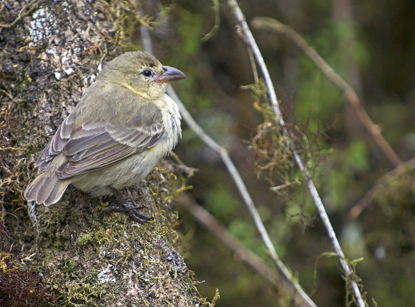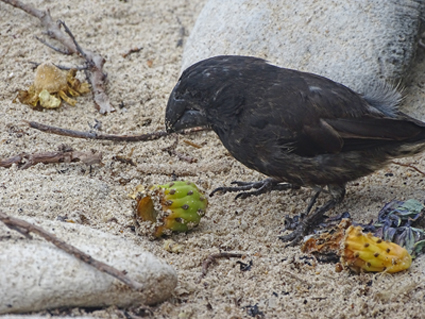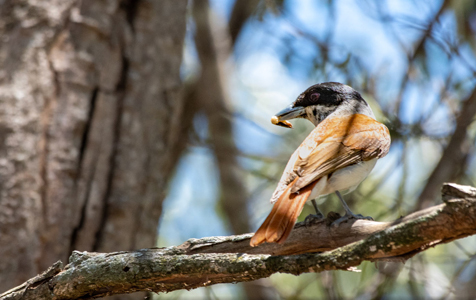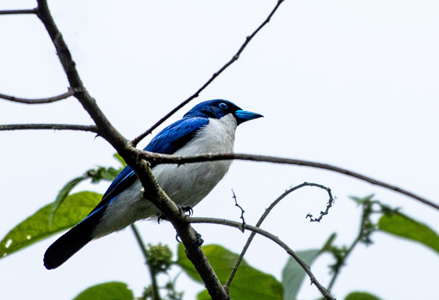If you are a nature enthusiast, chances are good that you’ve heard of Darwin’s finches. These unassuming birds have achieved notoriety even outside the naturalist sphere, and most folks could probably surmise that their significance has something to do with evolution. But what exactly is it that makes Darwin’s finches so special?

Darwin's Finches by Gould (From Darwin's The Voyage of the Beagle)
When Charles Darwin arrived in the Galapagos Islands in 1835, he had not yet begun to postulate his theory of evolution and was still, essentially, a creationist. He spent much of his time in this unusual landscape studying geology, but he also collected specimens of the local wildlife. He could not have known it at the time, but the Galapagos were uniquely well-positioned to provide him with his evolutionary eureka! moment.
Upon returning to England, Darwin examined his avian specimens with the help of ornithologist John Gould. They realized that a number of the birds belonged to a tight-knit group of ground finches that did not closely relate to any other known birds. While the finches were similar in many respects, Darwin noted that the shapes of their beaks formed a “perfect gradation…from one exceeding in dimensions that of the largest gros-beak, to another differing but little from than that of a warbler.”
In his Journal of Researches, Darwin postulated that “Seeing this gradation and diversity of structure in one small, intimately related group of birds, one might really fancy that from an original paucity of birds in this archipelago, one species had been taken and modified for different ends.” Later, in On the Origin of Species, he tied the birds to an ancestry on the South American continent, suggesting that they were colonists of the Galapagos and that such colonists would be “liable to modification”.

The Woodpecker Finch is found in more humid areas of many islands, using its thickened bill to hammer into rotten wood for food, and also using cactus spines or other tools to extract insects! (photo: Justin Peter)
Thus, the finches of the Galapagos were instrumental in moving Darwin towards the idea that species change, and that new species can arise from existing ones. The closely-related birds with their perfectly variable beaks provided a snapshot of a particular evolutionary process that we now call “adaptive radiation”.
In adaptive radiation, a single species rapidly diversifies into many new ones to take advantage of novel ecological opportunities. This may happen in response to a drastic change in the environment or – as in the case of Darwin’s finches – when the species colonizes someplace new.
The Galapagos Islands were formed by volcanoes, so for much of their relatively young existence they were not hospitable to wildlife. Over time, plants began to colonize the islands from seeds blown on the wind or drifting on the ocean. Later, animals arrived the same way. Ancestors of the infamous Galapagos Giant Tortoise, for example, likely washed to the islands on the ocean waves.
One of those early colonists was a small, finch-like bird from South America. On the Galapagos, this bird must have discovered an environment filled with insects, seeds, nectar, and other food sources, with nobody taking advantage of the buffet. Over the ensuing millennia these birds flourished, and different groups began to specialize on different types of food. This specialization gave rise to the differing beak shapes that Darwin observed, and the different species that exist today.

With the largest bill of all among Darwin's finches, the Large Ground Finch is well equipped to crack large seeds that its smaller-billed cousins are unable to tackle
Darwin’s finches are the most famous example of adaptive radiation – the one you’ll find in any evolution textbook – but they are far from the only instance of this phenomenon. On the other side of the world, on another remote island, there is a group of birds that mirrors them almost perfectly: the vangas of Madagascar.
If you’ve never specifically researched a trip to Madagascar, chances are good that you’re not familiar with them. But had Darwin’s voyage taken him to islands in the Indian Ocean instead of the Pacific, today’s textbooks might be filled with Darwin’s vangas, and the Galapagos finches might just be some little, drab birds that nobody has ever heard of.
The island of Madagascar was not formed by volcanoes but by tectonic drift, having once been sandwiched between Africa and Asia when they were joined in the supercontinent Pangaea. Some plants and animals were already present when the island broke apart from its neighbouring landmasses, but others arrived much later by the same means as the Galapagos colonists. The ancestor of the vangas was among the latter.
The vangas’ radiation took place much longer ago than that of the finches. It began about 25 million years ago, while the first finch likely arrived in the Galapagos just a few million years ago. The process, though, was essentially the same. When the first vanga arrived in Madagascar there were numerous vacant ecological niches, and take them is exactly what the vangas did.
Today there are 21 species of vanga inhabiting the widely varied habitats of Madagascar (and one on neighbouring Comoros) and – like Darwin’s finches – varied beak shapes are among their most notable characteristics. This makes some logical sense if food was the primary driver of diversification for both groups, as bird beaks are inexorably linked to their feeding biology. Some vanga beaks are strong and stout, some are long and slender, some are small and fine, and a few are truly remarkable.

Hook-billed Vanga showing its namesake hooked bill (Photo by: Mike Kent)

The Rufous Vanga has a stout but more average bill shape (Photo by: Mike Kent)
Two birds in this group are, at the top of the list of must-see birds for the country. The aptly-named Sickle-billed Vanga is equipped with a long and drastically decurved beak that is comically disproportionate to the rest of the bird. Though it looks too ridiculous to be functional, this specialized tool is used for probing holes and flaking tree bark in search of the vanga’s insect prey. The Sickle-billed Vanga is the vanga to see in the dry forests and savannahs of the country’s west.

Sickle-billed Vanga (Photo by: Pete Read)
In the wet forests of the northeast lives another remarkably- beaked bird: the Helmet Vanga. Madagascar’s answer to a hornbill or toucan, the Helmet Vanga’s most notable feature is its massive blue beak which stands in stark contrast to its black and brown plumage. Uniquely among the vangas, this beak is likely less an adaptation to feeding than an alluring display that serves to attract mates. The Helmet Vanga is an absolute jewel of the Madagascan rainforest.

Helmet Vanga (Photo by: Gabi Fehr)

The Madagascar Blue Vanga is among the more gaudy of the vangas (Photo by: Mike Kent)
If you want to share a glimpse of evolution with Darwin, the Galapagos is the destination for you. There’s no doubt that the finches that bear his name are foundational to his revolutionary theories, and thus our current knowledge of how the world works. But if you want to take the road less travelled and see Darwinian principles at work half a world away, consider the vangas of Madagascar. You will find so much else there, too!


